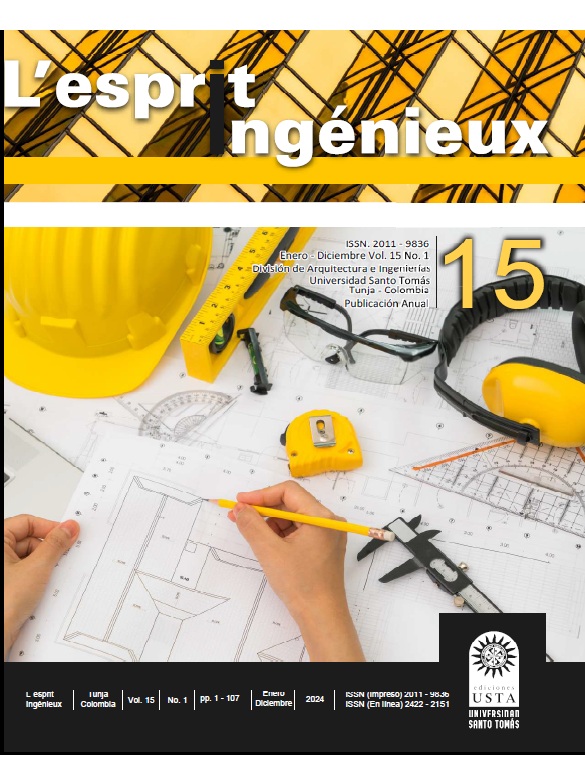Revisión De La Variación En Profundidad De Lagunas Facultativas
Main Article Content
Abstract
Stabilization ponds, and facultative ponds specifically, provide an optimal solution for wastewater treatment, focusing on the removal of BOD through various natural processes and pre-designed elements. When analyzing the factors that are most relevant in designing a facultative pond, the importance of retention time in relation to the depth at which the pond is designed was found. Taking these values into account, it was determined that the retention time is directly proportional to the depth, resulting in linear growth. This way, the possibility of studying the depth in more detail prior to the construction of a pond is analyzed in order to obtain appropriate retention times and efficiency in the purification of treated water.
Article Details
How to Cite
Cardona O, O. S., & Galán V, L. C. (2025). Revisión De La Variación En Profundidad De Lagunas Facultativas. L’esprit Ingénieux, 15(15), 117-126. Retrieved from http://revistas.santototunja.edu.co/index.php/lingenieux/article/view/3302
Section
Artículos
References
Acosta Castellanos, P. M.; Guerrero Sierra, H. & Vega, M. E. (2018). Estudios sobre medio ambiente y sostenibilidad: Una mirada desde Colombia. Ediciones USTA. http://hdl.handle.net/11634/22658
Acosta-Castellanos, P. M., & Pacheco-Garcia, B. H. (2024). Alternativa a la corrección de la eficiencia por DBO soluble en lagunas de estabilización . L’esprit Ingénieux, 13(1), 76-87. Recuperado a partir de https://revistas.santototunja.edu.co/index.php/lingenieux/article/view/3024
Acosta Castellanos, P. M. & Pacheco García, B. H. (2024). “Alternativa a la corrección de la eficiencia por DBO soluble en lagunas de estabilización”. Revista L’Esprit Ingénieux, 13(1), 76-87. Recuperado de: http://revistas.ustatunja.edu.co/index.php/lingenieux/article/view/3024
Acosta Castellanos, P. M. & Queiruga Dios, A. (2021). “From environmental education to education for sustainable development in higher education: A systematic review”. International Journal of Sustainability in Higher Education (ahead-of-print). Recuperado de: https://doi.org/10.1108/ijshe-04-2021-0167
Acosta Castellanos, P. M.; Queiruga Dios, A.; Hernández Encinas, A. & Ortegón, A. C. (2020). Analysis of environmental sustainability educational approaches in engineering education. Iberian Conference on Information Systems and Technologies, CISTI. Recuperado de:
https://doi.org/10.23919/CISTI49556.2020.9140919
García, J., & Magri, A. (2007). Lagunas de estabilización: Manual de diseño y operación. Comisión Nacional del Agua. Retrieved from https://www.cna.gob.mx.
Kellner E.; Pires E. C. (1998). “Lagoas de estabilização, projeto e operação”. Rio de Janeiro: Abes, pp. 13-17, 28-36, 48-59.
Matos, T. R. & Von Matos, M. (2006). "Variations in Pond Depth and Design: Impact on the Performance of Waste Stabilization Ponds." Faltan datos bibliográficos ¿????
Mara, D., & Pearson, H. W. (1998). Design manual for waste stabilization ponds in Mediterranean countries. Leeds, UK: Lagoon Technology International.
Metcalf & Eddy, Inc., & Tchobanoglous, G. (2003). Wastewater engineering: Treatment and reuse. Boston, MA: McGraw-Hill.
Peña, V. M., & Mara, D. (2004). Waste stabilisation ponds. The Netherlands: IRC International Water and Sanitation Centre.
Reed, S. C., & Crites, R. W. (1984). Natural systems for waste management and treatment. New York, NY: McGraw-Hill.
Romero Rojas, J. A. (2000). Tratamiento de aguas residuales por lagunas de estabilización (1ª ed.). Bogotá: Editorial Escuela Colombiana de Ingeniería. ISBN: 9701504038.
Silva S. A., Mara D. D. (1976). Tratamentos biológicos de águas residuárias: Lagoas de estabilização. Rio de Janeiro: Ed. Abes. 140 p.
Tchobanoglous, G., & Schroeder, E. D. (1985). Water quality: Characteristics, modeling and modification. Reading, MA: Addison-Wesley.
Von Sperling, M. (2007). Introduction to wastewater treatment processes. London, UK: IWA Publishing.
Acosta-Castellanos, P. M., & Pacheco-Garcia, B. H. (2024). Alternativa a la corrección de la eficiencia por DBO soluble en lagunas de estabilización . L’esprit Ingénieux, 13(1), 76-87. Recuperado a partir de https://revistas.santototunja.edu.co/index.php/lingenieux/article/view/3024
Acosta Castellanos, P. M. & Pacheco García, B. H. (2024). “Alternativa a la corrección de la eficiencia por DBO soluble en lagunas de estabilización”. Revista L’Esprit Ingénieux, 13(1), 76-87. Recuperado de: http://revistas.ustatunja.edu.co/index.php/lingenieux/article/view/3024
Acosta Castellanos, P. M. & Queiruga Dios, A. (2021). “From environmental education to education for sustainable development in higher education: A systematic review”. International Journal of Sustainability in Higher Education (ahead-of-print). Recuperado de: https://doi.org/10.1108/ijshe-04-2021-0167
Acosta Castellanos, P. M.; Queiruga Dios, A.; Hernández Encinas, A. & Ortegón, A. C. (2020). Analysis of environmental sustainability educational approaches in engineering education. Iberian Conference on Information Systems and Technologies, CISTI. Recuperado de:
https://doi.org/10.23919/CISTI49556.2020.9140919
García, J., & Magri, A. (2007). Lagunas de estabilización: Manual de diseño y operación. Comisión Nacional del Agua. Retrieved from https://www.cna.gob.mx.
Kellner E.; Pires E. C. (1998). “Lagoas de estabilização, projeto e operação”. Rio de Janeiro: Abes, pp. 13-17, 28-36, 48-59.
Matos, T. R. & Von Matos, M. (2006). "Variations in Pond Depth and Design: Impact on the Performance of Waste Stabilization Ponds." Faltan datos bibliográficos ¿????
Mara, D., & Pearson, H. W. (1998). Design manual for waste stabilization ponds in Mediterranean countries. Leeds, UK: Lagoon Technology International.
Metcalf & Eddy, Inc., & Tchobanoglous, G. (2003). Wastewater engineering: Treatment and reuse. Boston, MA: McGraw-Hill.
Peña, V. M., & Mara, D. (2004). Waste stabilisation ponds. The Netherlands: IRC International Water and Sanitation Centre.
Reed, S. C., & Crites, R. W. (1984). Natural systems for waste management and treatment. New York, NY: McGraw-Hill.
Romero Rojas, J. A. (2000). Tratamiento de aguas residuales por lagunas de estabilización (1ª ed.). Bogotá: Editorial Escuela Colombiana de Ingeniería. ISBN: 9701504038.
Silva S. A., Mara D. D. (1976). Tratamentos biológicos de águas residuárias: Lagoas de estabilização. Rio de Janeiro: Ed. Abes. 140 p.
Tchobanoglous, G., & Schroeder, E. D. (1985). Water quality: Characteristics, modeling and modification. Reading, MA: Addison-Wesley.
Von Sperling, M. (2007). Introduction to wastewater treatment processes. London, UK: IWA Publishing.

